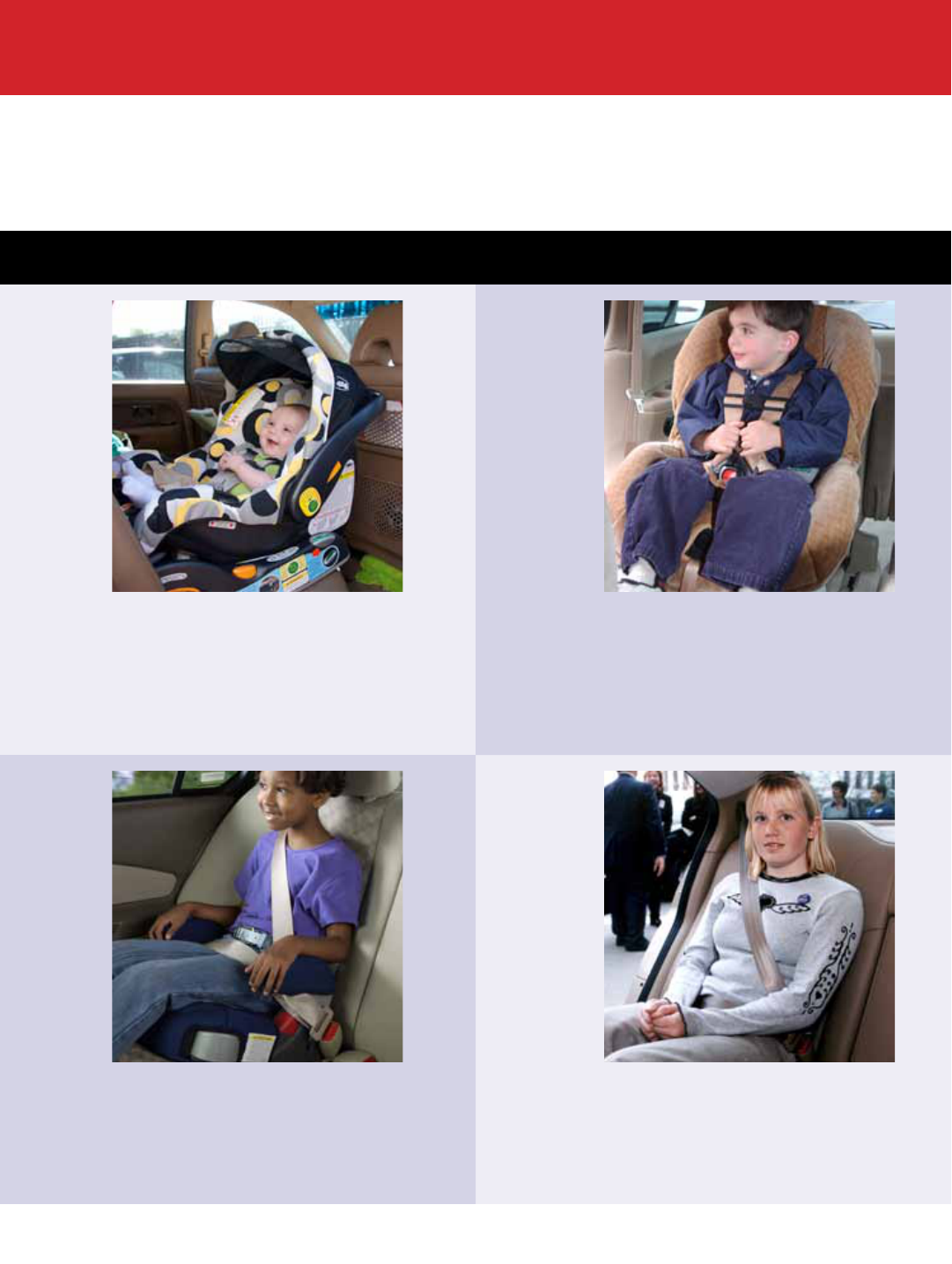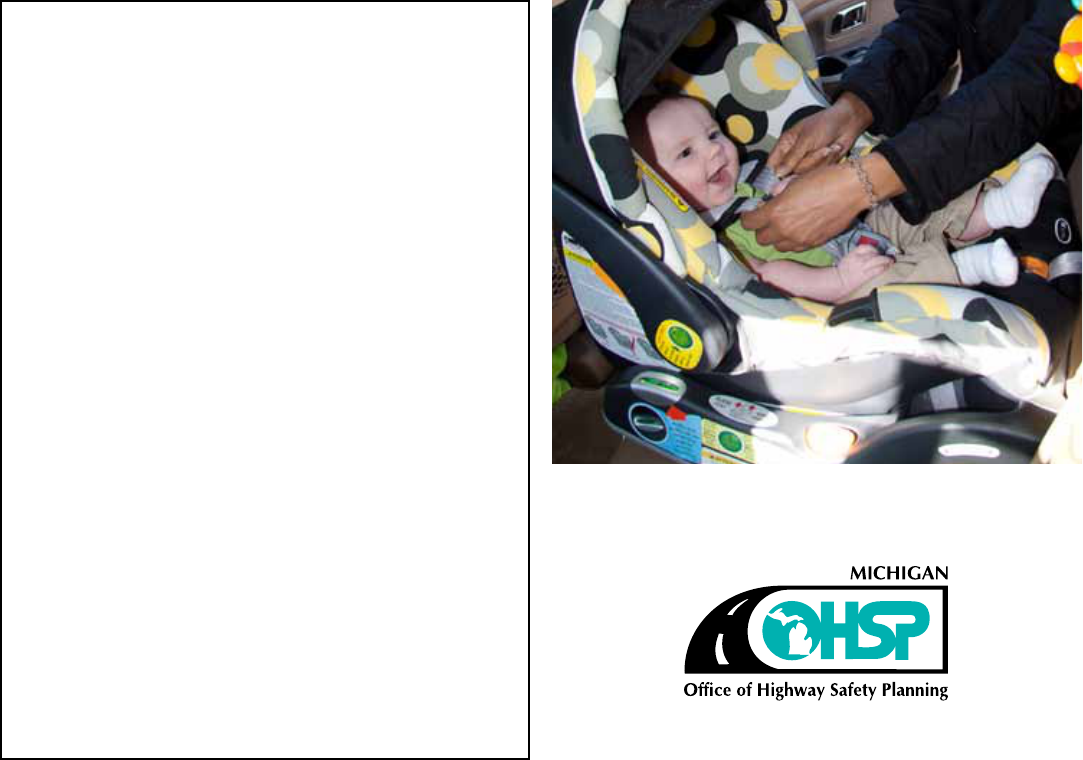
Car Seat Basics
The 4 Steps for Keeping a Child Riding Safely
STEP
1
REAR-
FACING
All babies and toddlers should ride in
rear-facing car seats until they are 2 years
old or until they reach the highest weight
or height limit allowed by the car seat.
STEP
2
FORWARD-
FACING
All children 2 years or older, or those
who have outgrown the weight or
height limit of their rear-facing seat,
should ride in a forward-facing car seat
with a harness for as long as possible
up to the highest weight or height
allowed by the car seat.
STEP
3
BOOSTER
SEATS
All children whose weight or height is
above the forward-facing limit for their
seat should use a belt-positioning booster
seat until the vehicle lap/shoulder belt ts
properly, typically when the child reaches
4’9” tall at 8–12 years old.
STEP
4
SEAT BELTS
When children are old enough and
large enough to use the vehicle seat
belt alone, always use lap and shoulder
belts for optimal protection.
ALL CHILDREN YOUNGER THAN 13 YEARS OLD SHOULD BE RESTRAINED IN THE REAR SEAT OF VEHICLES.
Source: American Academy of Pediatrics, Policy Statement, April 2011
Motor vehicle crashes are the leading cause of death for young children, and
properly restrained children have a more than 50 percent greater chance of
surviving a crash. When driving with children, always use the appropriate
car seat or seat belt.
To learn more or locate a certied child safety technician, visit NHTSA.gov.

Common car seat mistakes and how to avoid them
More than 70 percent of car seats are not installed properly.
Most common errors are easy to x with just a few adjustments.
THE HARNESS STRAPS ARE NOT TIGHT ENOUGH.
• Harness straps should t snug to the child’s body and should
pass the “pinch test,” meaning you should not be able to
pinch any excess strap material.
THE CAR SEAT ISN’T INSTALLED TIGHT ENOUGH.
• Car seats, whether installed with the seat belt or LATCH sys-
tem, should not move more than one inch from side to side
when tested at the point where the car seat attaches to the
vehicle.
MOVING CHILDREN TO THE NEXT STEP TOO SOON.
• Children should stay in their car seats until they outgrow the
height or weight limit of the seat before moving to the next
step, such as rear-facing to forward-facing.
THE CHEST CLIP IS TOO LOW.
• The chest clip should be secured at the child’s armpits to
ensure straps remain in the correct position.
PUTTING KIDS IN THE FRONT SEAT TOO EARLY.
• Children should ride in the back seat of the vehicle until
they reach 13 years old. The force of an air bag may be too
intense for children under the age of 13.
TIPS FOR BUYING CAR SEATS
You should never purchase or borrow a used car seat that:
• Has been involved in a crash
• Has been recalled
• Has no date of manufacture and/or model number
• Has expired (typically after six years)
• Is damaged or missing parts
Car seats should not be purchased at garage sales
or second-hand stores since the history of the seat is
unknown.
MICHIGAN CHILD PASSENGER SAFETY LAWS
Michigan law requires all children younger than age 4 to
ride in a car seat in the rear seat if the vehicle has a rear
seat. In addition:
• If all back seats are occupied by children under 4, then a
child under 4 may ride in a car seat in the front seat.
• A child in a rear-facing car seat may only ride in the
front seat if the air bag is turned o.
• Children must be properly buckled in a car seat or
booster seat until they are 8 years old or 4’9” tall.
• All passengers under 16 years old must use a seat belt in
any seating position. All front seat occupants must use a
seat belt regardless of age.
Children should never ride on a lap, in a portable crib, or in
any other device not approved for use in the vehicle.
Not paid for with state funds. Paid for with funding from the U.S. Department of Transportation.
P.O. Box 30634 • Lansing, MI 48909
(517) 241-2500
Michigan.gov/ohsp
